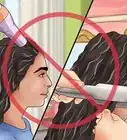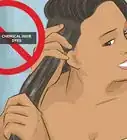This article was co-authored by Jessica Davis. Jessica Davis is a Master Cosmetologist and a Cosmetology Instructor with over 19 years of hair salon experience. Jessica is a USTI/AMCA board certified Trichologist, a Natural Hair Care Specialist, and a Master Educator with U.S. Trichology Institute. She is a member of the US Trichology Board of Directors, the National Association of Women Owned Small Businesses, and the Cicatricial Alopecia Research Foundation. She specializes in Afro-textured hair and hair loss, and was given the Associate Trichologist award for her contributions to the field.
wikiHow marks an article as reader-approved once it receives enough positive feedback. In this case, 92% of readers who voted found the article helpful, earning it our reader-approved status.
This article has been viewed 332,504 times.
Caring for African-textured hair can be difficult to manage, due to its coarse, kinky, and often dry texture. Perms, hair coloring, and heat can make matters worse with split ends, dull and lifeless appearance, and inability to hold curls. No worries — with this guide and a little patience and consistency, you can restore your hair to health.
Steps
Caring for Damaged Hair
-
1Trim away damage if possible. Caring for damaged hair is a long, difficult process, and it will likely never return to full healthy. If you're not willing to cut your hair short, consider trimming away split ends, a common problem in damaged hair.[1]
- Repeat the trim every 4–6 weeks, removing all the split ends you can find. Leaving damaged ends in place will not help your hair grow out.
-
2Exfoliate your scalp. To begin your hair care mission, apply a scalp preparation to remove buildup from sebum and hair products. This will create a healthy environment and provide nourishment to the scalp and follicles.
- Besides removing sebum buildup, a good scalp preparation product provides hair-strengthening vitamins and soothes dry, irritated scalp. Ask a salon to recommend a product similar to Scalp Prep.
Advertisement -
3Protect the ends of your hair. Every week, seal away the ends of your hair with shea butter. For further protection, sleep on a satin pillow, or with a satin or mesh scarf over your hair.[2] Cotton or fleece pillowcases will pull your hair out and cause breakage.
- If you have extra-porous hair, shea butter may makes your hair feel limp and greasy. Try a light moisturizer instead, or a light oil such as jojoba oil.
-
4Use leave-in conditioner daily. Leave-in conditioner restores natural oils without requiring water. Put this in your hair daily to encourage health and shine.
-
5
-
6Apply protein treatments every other week. Hair damaged by coloring or relaxer is often low on protein. Once every two weeks, apply a protein treatment to restore strength. Follow label instructions for best results.
-
7Deep condition weekly. Every week, massage a moisturizing conditioner into your hair. Hold your hair over steam to encourage the conditioner to penetrate your hair's inner layers. Put your hair up and leave it in for at least a couple hours, or overnight.
- A hot oil treatment can provide similar benefits.
-
8Wear a protective style. Cornrows, plats, or twists help reduce damage from exposure. Even if you wear your hair down during the day, put your hair in one of these styles before going to bed.
-
9Brush and comb your hair regularly. Work out tangles gently, without yanking your hair. Damaged hair breaks easily when combed dry, so add a small amount of conditioner or water.
- For best results, use a brush with rubber bristles, such as a Denman brush.
Preventing Damage
-
1Reduce frequency of chemical treatments. If using chemicals is an absolute must, wait for as long as you can between treatments. If possible, wait for 2 inches (5cm) of new growth before the next application.[4]
-
2Switch to natural coloring agents. Henna is an all-natural treatment that will color your hair and help condition it at the same time. Try this instead of damaging your hair with hair dye and bleach.
-
3Use heat protectant before all heat treatments. A quality heat protectant will reduce damage from heat. Add this to your hair before blow-drying, using a flat iron, or any other styling treatment that involves heat.[5]
- Look for a heat protectant that also provides nutrients to improve shine and texture.
Warnings
- Make sure your braids aren't too tight, they strain your scalp and cause bumps.⧼thumbs_response⧽
- Stay away from perms, hair dye, and heat. Let your hair grow out naturally.⧼thumbs_response⧽
- Do not grease your scalp, as this can clog your pores and lead to breakage and damage.⧼thumbs_response⧽
References
- ↑ https://www.byrdie.com/bad-things-to-do-to-black-hair-400140
- ↑ https://www.cosmopolitan.com/uk/beauty-hair/hair/advice/a39629/afro-hair-care/
- ↑ https://www.byrdie.com/bad-things-to-do-to-black-hair-400140
- ↑ https://www.aad.org/public/skin-hair-nails/hair-care/african-american-hair
- ↑ https://www.aad.org/public/skin-hair-nails/hair-care/african-american-hair
About This Article
To care for your damaged African-textured hair, apply leave-in conditioner each day, which doesn’t require water and will make your hair more shiny. You can also apply shea butter or a light moisturizer every week to protect the ends of your hair and reduce the risk of split ends. Try to brush or comb your hair regularly so you can remove tangles and keep it looking good. If you want to make your hair healthier, apply a scalp protection product once a week, which will get rid of any build-up of hair products on your scalp and give important nutrients to your hair. Remember to get your hair trimmed every 4 to 6 weeks to remove any split ends. For tips on how to color your hair if it’s prone to damage, keep reading!





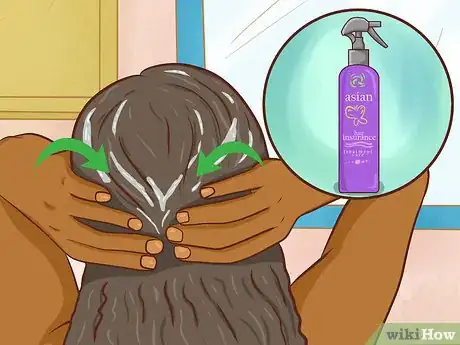




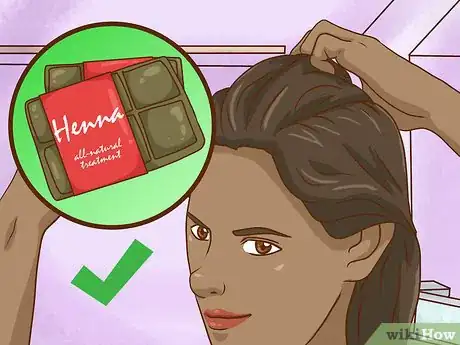



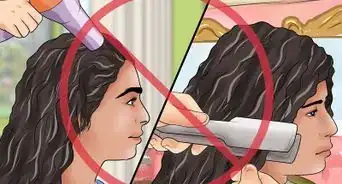





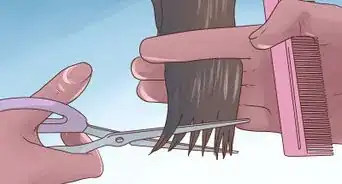

-Step-20.webp)












